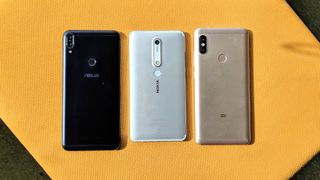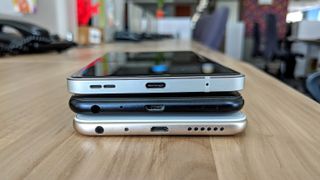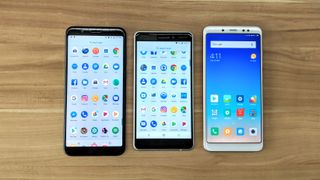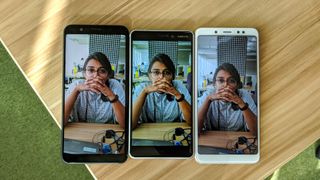Comparison: Redmi Note 5 Pro vs Zenfone Max Pro M1 vs Nokia 6 (2018)
Picking out the real budget king

It’s no more a secret that India has a huge market for entry-level to mid-range smartphones. And I am not picking up any survey or report to claim that, it’s the sheer number of options available in this range that tells the story.
According to Counter Point research, Xiaomi leads the Indian smartphone market with 31.1% of the market share (in terms of shipments) in Q1 2018. The report attributes Xiaomi’s success to their extensive presence in the budget segment.
Even though Xiaomi has held a dominant position in the sub 15K category, there's still some serious competition coming from either Moto, Honor, and now, even Asus.
Nokia was quick to learn from the mistakes and has hit back with better options. Moto hasn't entered the market just yet. So this makes the Redmi Note 5 Pro , Nokia 6 (2018) and the Zenfone Max Pro M1 the worthy contenders for the comparison. We have reviewed all of them and trust us, the competition is really close.
This neck-to-neck competition also means that phones in 2018 have become more powerful, efficient and tougher to differentiate. But well, we do what we do and we've simplified it for you. Read on...
Design and build

First off, the build quality of all three phones is solid and none of them gives you a chance to complain when you talk about durability. Also, all the phones have a good grip.
But...
Get daily insight, inspiration and deals in your inbox
Get the hottest deals available in your inbox plus news, reviews, opinion, analysis and more from the TechRadar team.
The Redmi Note 5 Pro sports a boring and dated look, that may not appeal to most users who care about design. It is tall, has a vertical camera that imitates the iPhone X, rest remains the same as the Redmi Note 4.
The Asus Zenfone Max Pro M1 is on a similar design language as Xiaomi's. It looks more like a Redmi 5 with a dual vertical camera with no protrusion in a thicker and taller form factor. Not very comfortable to operate with one hand and looks like other metal unibody phones from Chinese brands.
The best one is the Nokia 6 (2018), and there are more than just one reason. The way Nokia advertises it, expecting it to have a solid build quality is evident, but it's not the only thing here.
The prime benefit it has is its stand-out identity. It's not an iPhone X clone or just a lazy attempt at designing. The hard work is visible and it's more than just solid. It has an identity of its own and is currently among the most well-built phones around.
Nokia 6 (2018) doesn't come in funky colours like its Lumia phones, neither does it have a curvy design. It is just plain blocky phone with precise finishing and subtle yet empowering design elements.
The other two phones have a 18:9 display that makes them tall, but the Nokia 6 still has a 16:9 panel which is broader. The overall design is short and broad, and that feels much better to grip on to and use with one hand.

Performance and software
Among the three phones, the Note 5 Pro and the Max Pro M1 share similar hardware specifications. On paper, the Nokia 6 (2018) has a slightly inferior Snapdragon 630, while the other two feature the latest Snapdragon 636 chipset.
Performance wise, none of the phones really allow you to complain for their price. But if you've to put them on a rank board, the Redmi Note 5 Pro and the Zenfone Max Pro M1 fight closely for the first position, while the Nokia 6 (2018) comes second with a small margin.
Conditions like multitasking, prolonged gaming, or shooting videos is where the Nokia 6 (2018) lags behind in comparison. Other day-to-day tasks are well handled by all three.
On the technical side, with eight Kryo 260 cores clocked up to 1.8 GHz, the Snapdragon 636 has almost double the performance and gaming prowess than the 630 with Cortex-A53 clocked up to 2.20GHz.
So power-users are advised to go for either of the phones with the Snapdragon 636, but i'd personally prefer Note 5 Pro for its optimisation.
Software
Here the Nokia 6 (2018) bounces back with its clean and easy to use software experience and Android One guarantee for future updates. On similar lines, the Zenfone Max Pro M1 also runs stock Android, but it's not registered under the Android One program, so, no Google guarantee for prioritised updates.
Navigation, opening and closing of apps isn't stuttery on any of the phones. The MIUI does feel heavy next to the pure Android phones, but it also packs some extra features on top. MIUI looks heavy, but is quite well optimised and doesn't feel the way it looks. Still, it has an older version of Android running with no confirmed timeline of update to Oreo.
The other two run the latest Android Oreo 8.1, which is a huge decision-making factor for many.

Display
All the phones have distinct displays. The Nokia 6 (2018) and the Note 5 Pro reproduce accurate colours and cooler tones, whereas the M1 has a tinge of yellow on it.
The top two will be the Nokia and Redmi, but due to its 18:9 aspect ratio and larger size, the Redmi Note 5 Pro shines for multimedia lovers. But if you prefer a handy phone over a larger display, then Nokia 6 (2018) should suffice.
All the phones have decent viewing angles, ample of brightness and good touch response, but Nokia 6 (2018) has the smoothest and quickest touch response amongst them all.
Battery
Out of the three phones, the Zenfone Max Pro M1 has the biggest battery on paper. Followed by Redmi Note 5 Pro and then Nokia 6 (2018), and so is the case in real life as well.
The Max Pro M1 with its 5000mAh battery scored 11 hours 13 minutes on PCMark 2.0. The Note 5 Pro scored 10 hours 39 minutes and the Nokia 6 (2018) scored 6 hours 59 minutes.
Asus has raised the competition with a bigger battery here and the the Nokia 6 falls out of it by a huge margin.

Camera
Of all the three phones we're comparing, only the Nokia 6 (2018) lacks a dual camera system. While the Redmi Note 5 Pro has impressed us in the past, the other two were the not very impressive.
But when we put the samples side by side, there were instances where the other two surprised us. Below are few examples-

In the picture above, the M1 is stands out with its oversaturated colours and warmer tones. The Note 5 Pro and Nokia 6 (2018) produced somewhat similar results, but the Note 5 Pro captured more details and was closer to the source colours in this picture. Although the Nokia 6 reproduced better reds - it is neither overpowering nor undersaturated...

Once again, the Redmi Note 5 Pro reproduces better colours and finer details. The Nokia 6 has introduced a yellow hue to the shells, whereas the other two perform better in that department.

In dim light, the colours are very well reproduced by all three, but Nokia 6 and Note 5 have captured the right tone, as you can see on the white part on the right of the pictures. The good thing about the Nokia 6 is that there's neither a greenish tint on the wall like you see with the Max Pro M1, nor does it have the vignette effect like the Note 5 Pro, but again, the Note 5 Pro captured more details than the other two.

I clicked this picture without stabilising my hands and I realised that the Redmi Note 5 Pro is the most stable among the three. The Asus does good in well-lit conditions, but the Nokia 6 fails almost entirely when it comes to capturing a clear shot with unstable hands.
Redmi Note 5 Pro is also quicker at image processing and locking focus on objects. The worst among the three in terms of processing speed and autofocus is the Max Pro M1, especially because of the inconsistency.

In low light, the Note 5 Pro beats the other two by a huge margin. Although, none of these phones are good for low-light photography, the Redmi still has some skills stacked for it. The image processing algorithm isn't just faster, but also more efficient at reducing noise without compromising on details.
The Nokia 6 (2018) is just incapable when it comes to low light photography, so is the Zenfone. So, all in all, the most reliable camera among the three is the Redmi Note 5 Pro under the 16K price segment.
What's more?
Nokia 6 (2018) is the only phone that comes with a USB Type-C port for data syncing and charging. Honestly, it is unconvincing to see a micro USB port on a phone that claims to be the best in its category in 2018.
The Note 5 Pro has a 6GB RAM variant for Rs 15,999 and the Max Pro M1 will also get a 6GB RAM variant sometime soon for 14,999. The Nokia 6 (2018) costs Rs 15,999 for 4GB RAM, but we didn't experience a huge difference in terms of performance.
So, which one do you buy?
The Redmi Note 5 Pro looks like the most complete handset among the three. Sure, the Zenfone Max Pro M1 has everything that Note 5 Pro offers, but the camera isn't at par. What it has over the Redmi Note 5 Pro is the latest version of Android in its purest form and a slightly bigger battery.
The Nokia 6 (2018) has the best built and software. If you demand longevity and durability from your phone, this could be the safest option. It offers more quality than quality, but its camera is the biggest deal breaker.
Sudhanshu Singh have been working in tech journalism as a reporter, writer, editor, and reviewer for over 5 years. He has reviewed hundreds of products ranging across categories and have also written opinions, guides, feature articles, news, and analysis. Ditching the norm of armchair journalism in tech media, Sudhanshu dug deep into how emerging products and services affect actual users, and what marks they leave on our cultural landscape.
His areas of expertise along with writing and editing include content strategy, daily operations, product and team management.

